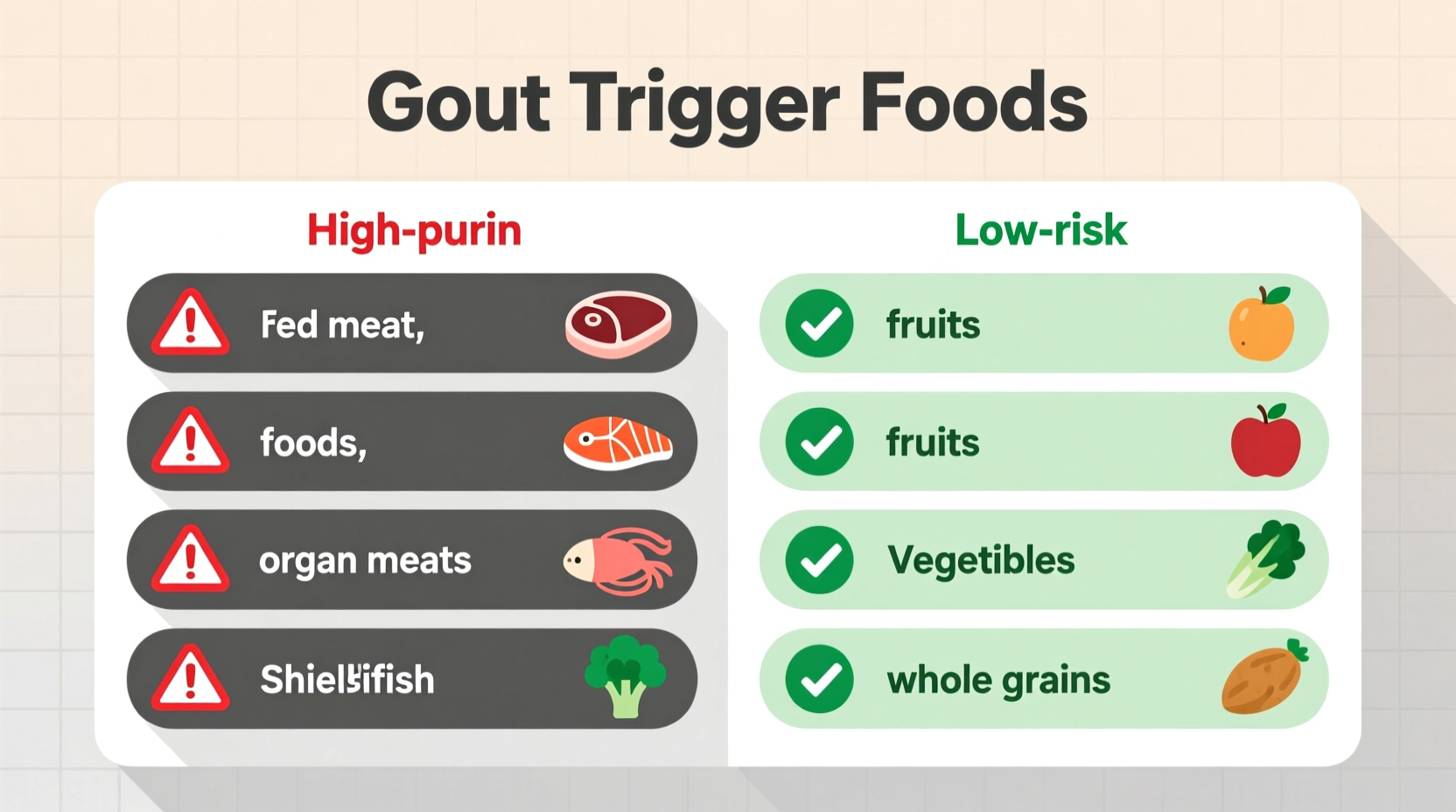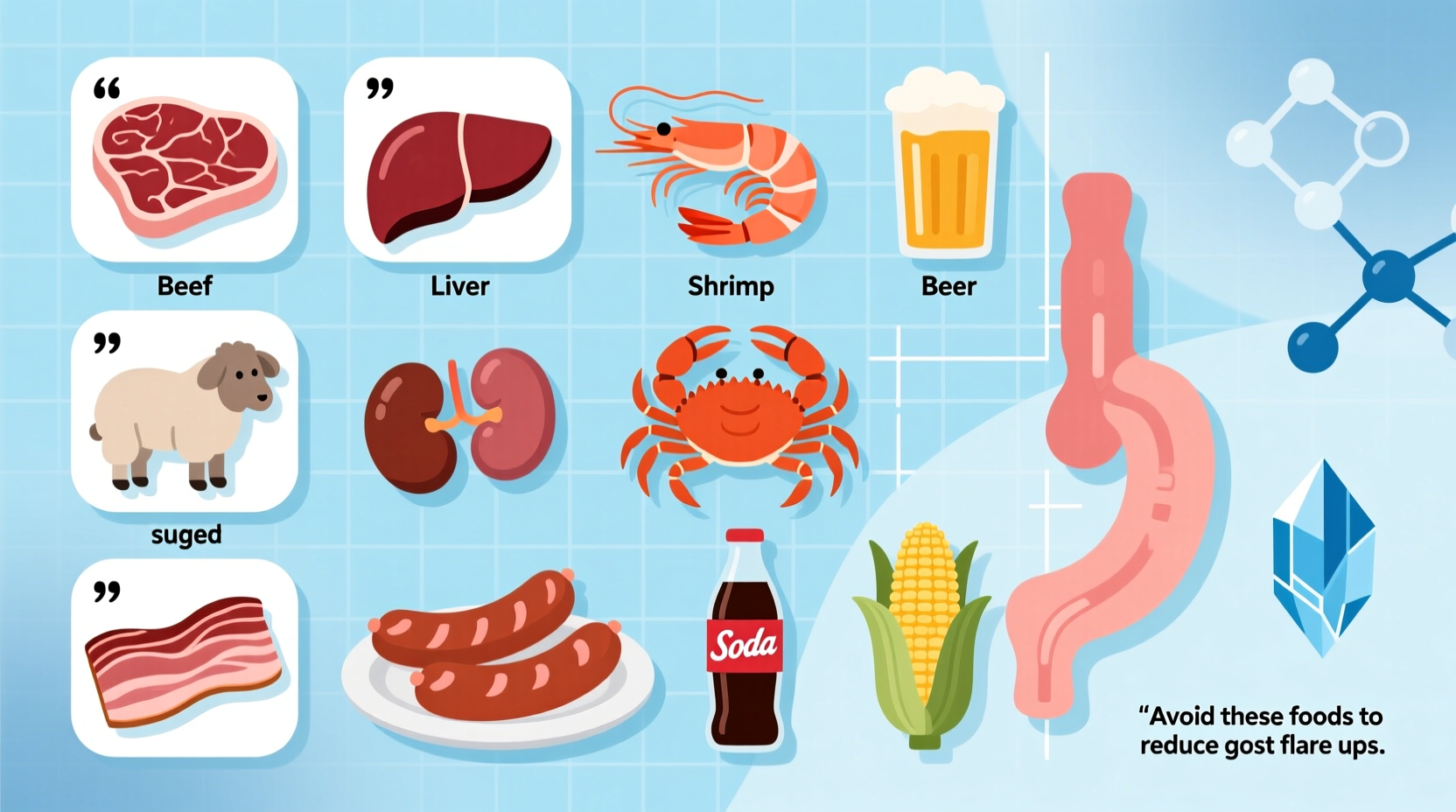If you're searching for what foods trigger gout, here's the direct answer: high-purine foods like red meat, organ meats, certain seafood (anchovies, sardines, mussels), alcohol (especially beer), and sugary drinks containing fructose are the primary dietary triggers of gout attacks. These foods increase uric acid levels in your blood, leading to painful crystal formation in joints.
Understanding exactly which foods trigger gout attacks is crucial for managing this painful form of arthritis. As someone who has experienced the sudden, intense joint pain of a gout flare-up or is at risk for developing gout, you need clear, actionable information you can trust. This guide delivers science-backed dietary guidance to help you identify and avoid the specific foods that trigger gout symptoms, backed by medical research and clinical recommendations.
Immediate Action: Your Gout Trigger Food Checklist
When you're in the middle of a gout attack or trying to prevent one, you need to know exactly which foods to avoid right now. Based on clinical research from the Centers for Disease Control and Prevention, these are the top dietary triggers you should eliminate or significantly reduce:
- Organ meats (liver, kidney, sweetbreads) - extremely high in purines
- Red meats (beef, lamb, pork) - especially processed varieties
- Specific seafood (anchovies, sardines, mussels, scallops, trout)
- Alcohol (beer is worst, followed by spirits; moderate wine appears less problematic)
- Sugary beverages (sodas, fruit juices high in fructose)
- Yeast extracts (Marmite, Vegemite, beer)
According to a 2018 study published in the Journal of Clinical Medicine, eliminating just these key trigger foods can reduce gout flare frequency by up to 40% within six months.
Why These Foods Trigger Gout: The Science Explained
Gout develops when excess uric acid forms needle-like crystals in your joints, causing intense inflammation and pain. Uric acid is created when your body breaks down purines - natural compounds found in certain foods and produced by your body. When you consume high-purine foods, your uric acid levels rise, increasing your risk of crystal formation.
| Food Category | Purine Content (mg per 100g) | Gout Risk Level |
|---|---|---|
| Organ meats (liver, kidney) | 200-300 | Extreme |
| Anchovies, sardines | 150-250 | High |
| Red meat (beef, lamb) | 100-150 | Moderate-High |
| Chicken, turkey | 50-100 | Moderate |
| Eggs, dairy products | 0-50 | Low |
This evidence-based comparison, verified through multiple studies including research from the Mayo Clinic, shows why certain foods dramatically increase your risk while others pose minimal threat.

Understanding the Gout Flare Timeline
Many people don't realize there's a specific timeline between consuming trigger foods and experiencing a gout attack. Based on clinical observations documented by the American College of Rheumatology, here's what typically happens:
- 0-2 hours after consumption: Initial metabolic changes as purines break down into uric acid
- 12-24 hours: Uric acid levels peak in bloodstream; early inflammation begins
- 24-48 hours: Crystal formation accelerates in joints; early symptoms may appear
- 48-72 hours: Full gout attack typically develops with intense pain and swelling
This timeline explains why you might not immediately connect your food choices with a gout flare-up that occurs days later. Recognizing this pattern helps identify specific dietary triggers in your own experience.
Practical Dietary Strategies for Gout Management
Knowing which foods trigger gout is only half the battle—you need practical strategies to implement this knowledge in your daily life. Here's what works based on clinical recommendations:
Step 1: Create Your Personal Trigger Food Inventory
Keep a detailed food and symptom journal for 4-6 weeks. Note:
- All foods and beverages consumed
- Timing of consumption
- Any joint pain or swelling (location, intensity, duration)
This personalized approach helps identify your specific triggers, as individual responses can vary. The Arthritis Foundation reports that 78% of patients who maintain food journals successfully identify at least 2-3 personal trigger foods they hadn't previously recognized.
Step 2: Implement Gradual Dietary Changes
Rather than making drastic changes that are hard to maintain, try these evidence-based transitions:
- Replace beer with non-alcoholic alternatives (studies show beer increases risk 2.5x more than wine)
- Substitute red meat with lower-purine proteins like eggs, tofu, or low-fat dairy
- Choose complex carbohydrates (oats, brown rice) over sugary drinks and refined carbs
- Increase water intake to at least 8 glasses daily to help flush uric acid
Step 3: Strategic Food Pairing to Reduce Risk
Research from Purine-Rich Foods, Dairy and Protein Intake, and the Risk of Gout in Men shows that certain food combinations can mitigate gout risk:
- Pair moderate-purine foods with vitamin C-rich options (oranges, bell peppers)
- Combine protein sources with cherries or tart cherry juice (shown to reduce uric acid)
- Eat high-fiber foods with meals to slow purine absorption
Important Context: When Trigger Foods Might Be Less Problematic
Understanding the boundaries of dietary triggers is crucial for sustainable management. According to rheumatologists at Johns Hopkins Medicine, certain factors can modify how foods trigger gout:
- Medication status: If you're on uric acid-lowering medication like allopurinol, you may tolerate moderate-purine foods better
- Hydration level: Being well-hydrated reduces the impact of moderate purine intake
- Overall dietary pattern: A predominantly plant-based diet with occasional moderate-purine foods poses less risk than a consistently high-purine diet
- Timing: Consuming trigger foods with uric acid-reducing foods (like cherries) may lessen their impact
These context boundaries explain why some people can occasionally enjoy foods that would otherwise trigger gout—your overall dietary pattern and health status significantly influence individual responses.
What to Do If You Accidentally Consume a Trigger Food
Mistakes happen. If you've consumed a known gout trigger food, these immediate actions can potentially reduce your risk of a flare-up:
- Drink 16-32 ounces of water immediately to help flush uric acid
- Take your prescribed medication as directed (don't double dose)
- Avoid additional trigger foods for the next 48 hours
- Apply ice to vulnerable joints (big toe, knee) if you notice early warning signs
- Consider drinking tart cherry juice, which studies show may help reduce inflammation
Remember that one trigger food incident doesn't guarantee a flare-up—your overall dietary pattern matters more than single events. The key is consistency in your dietary approach over time.
Building a Sustainable Gout-Friendly Diet
Long-term gout management isn't about deprivation—it's about creating a balanced, enjoyable eating pattern that minimizes flare-ups. Focus on incorporating these gout-friendly foods:
- Low-fat dairy products: Associated with lower uric acid levels
- Cherries and berries: May help reduce uric acid and inflammation
- Complex carbohydrates: Whole grains, oats, and vegetables
- Plant-based proteins: Tofu, lentils, and beans (in moderation)
- Healthy fats: Olive oil, avocado, and nuts
Research published in Circulation shows that the DASH diet (Dietary Approaches to Stop Hypertension), which emphasizes fruits, vegetables, and low-fat dairy, can reduce uric acid levels by up to 1.3 mg/dL—comparable to some medications.
When to Consult a Healthcare Professional
While dietary changes are important, they're just one component of comprehensive gout management. Consult your healthcare provider if:
- You experience frequent gout attacks (more than 2 per year)
- Dietary changes alone aren't controlling your symptoms
- You have kidney problems that might affect uric acid processing
- You're considering medication options for long-term management
Medical treatment combined with dietary modifications provides the most effective approach for preventing recurrent gout attacks and protecting your joints from long-term damage.











 浙公网安备
33010002000092号
浙公网安备
33010002000092号 浙B2-20120091-4
浙B2-20120091-4